Mirfak, designated as Alpha Persei, is the brightest star in the northern constellation of Perseus. It is a supergiant star that may well host an exoplanet much more massive than Jupiter.
Key Facts & Summary
- Mirfak is a solitary star located at around 510 light-years away from our Solar System.
- It has an apparent magnitude of 1.806, being visible to the naked eye and outshining the constellation’s best-known star, Algol.
- Its absolute magnitude is -5.1.
- Mirfak is a supergiant star of spectral type F5 lb, being in the latter stages of its evolution, and its spectrum is similar to Procyon.
- This star is truly big, having 8.5 solar masses, and a whopping 68 solar radii.
- Mirfak is also quite a young star, being around 41 million years old at best.
- Despite its enormous size, Mirfak is only slightly hotter than our Sun, having surface average temperatures of around 6,350 K.
- Mirfak has a radial velocity of -2.04 km / -1.26 mi per second, while its rotational velocity is 20 km / 12.4 mi per second.
- The surface gravity on Mirfak is at around 1.90 cgs.
- This star is circumpolar when viewed from mid-northern latitudes.
- Mirfak lies amid a cluster of stars named the Alpha Persei Cluster, or Merlotte 20, which is easily visible with binoculars. This cluster includes many fainter stars of Perseus.
- Mirfak is the 33rd brightest star in the night sky, sharing this place with Dubhe, from Ursa Major.
- The two stars are fainter than Alnair in Grus, Alnitak in Orion, and Alioth in Ursa Major, but they outshine Regor in Vela, Wezen in Canis Minor, and Kaus Australis in Sagittarius.
- Mirfak is among the 58 stars selected for celestial navigation. It is the only navigational star in Perseus.
- The constellation of Perseus is among the 48 constellations listed by the Greek astronomer Ptolemy in his 2nd century Almagest.
Alpha Persei bears the name Mirfak. This name is of Arabic origin, being the word for “elbow”, and it comes from the phrase al-Mirfaq uth-Thurayya.
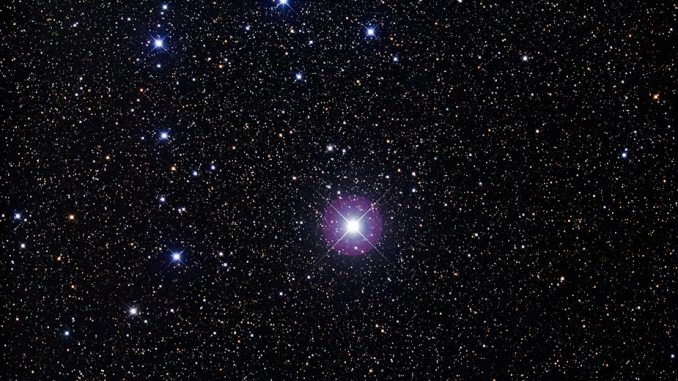
This phrase refers to the elbow of the Pleiades. The IAU officially approved the named Mirfak for Alpha Persei in 2016.
Formation
Mirfak is part of the Alpha Persei Cluster, or Alpha Persei Moving Group, which consists of massive blue class B stars that formed together around the same time and continue to move together through space.
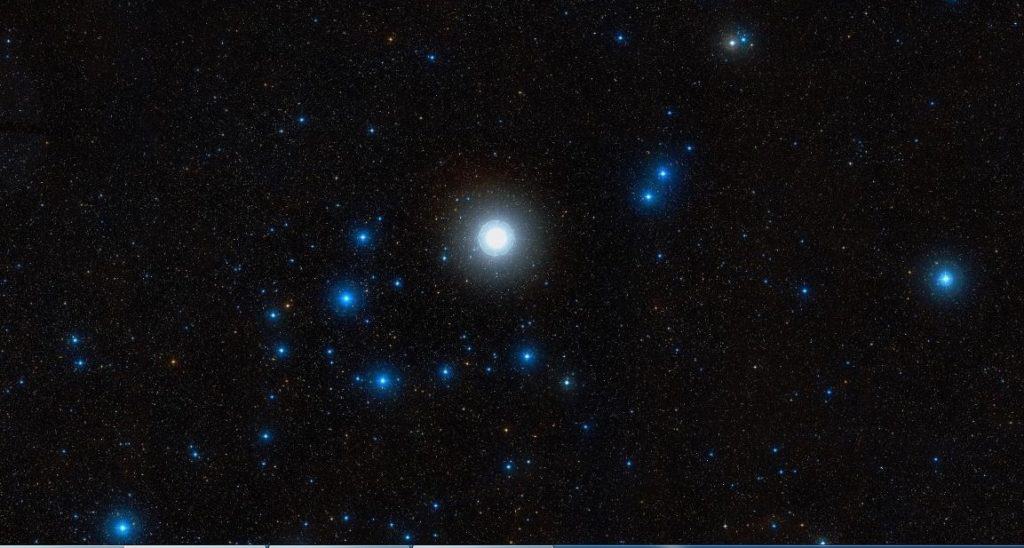
This cluster is also designated as Collinder 39, and Melotte 20. It has an apparent magnitude of 1.2 and occupies an area of 185’. The estimated age of this cluster is between 50 to 70 million years.
Distance, Size, and Mass
Mirfak is situated at around 510 light-years / 155 parsecs away from our Solar System. It is bright enough to be seen with the naked eye under good conditions.
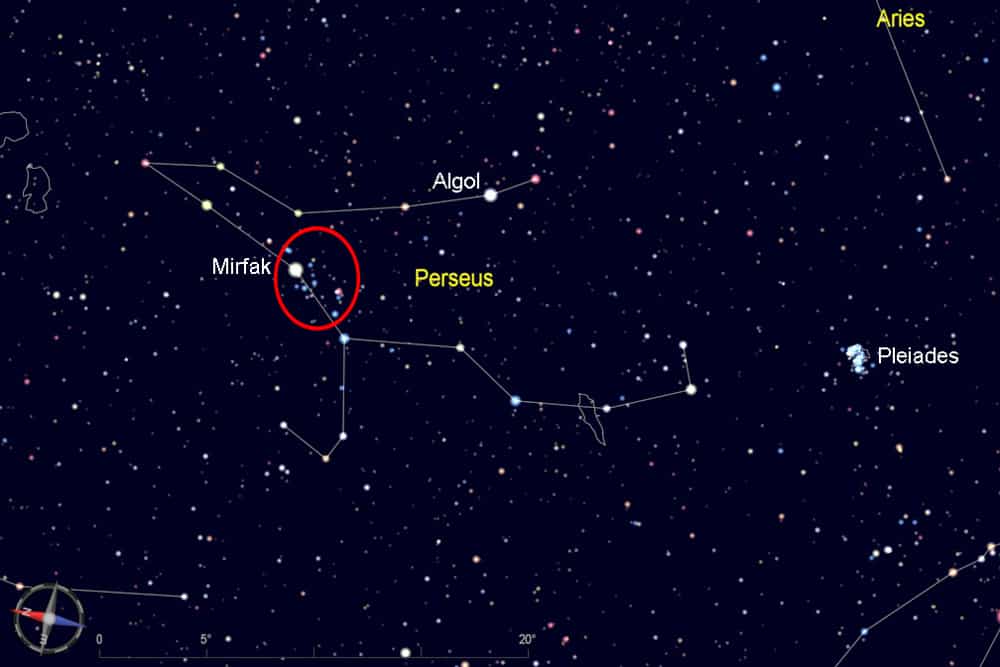
This star is huge and quite massive, having 8.5 solar masses, or 850% of our Sun’s mass, and 68 solar radii, or 6,800% of our Sun’s radius. Thus, Mirfak is more than 100 times bigger than our Sun.
Other Characteristics
Mirfak is an evolved supergiant star of spectral type F5 lb, appearing yellow-white in color. its spectrum is similar to Procyon. This star is more than 5,000 times brighter than our Sun, having an apparent magnitude of 1.806, and an absolute magnitude of -5.1.
Mirfak is the 33rd brightest star in the night sky, sharing this place with Dubhe, from Ursa Major. It is only slightly hotter than our Sun, having surface average temperatures of around 6,350 K.
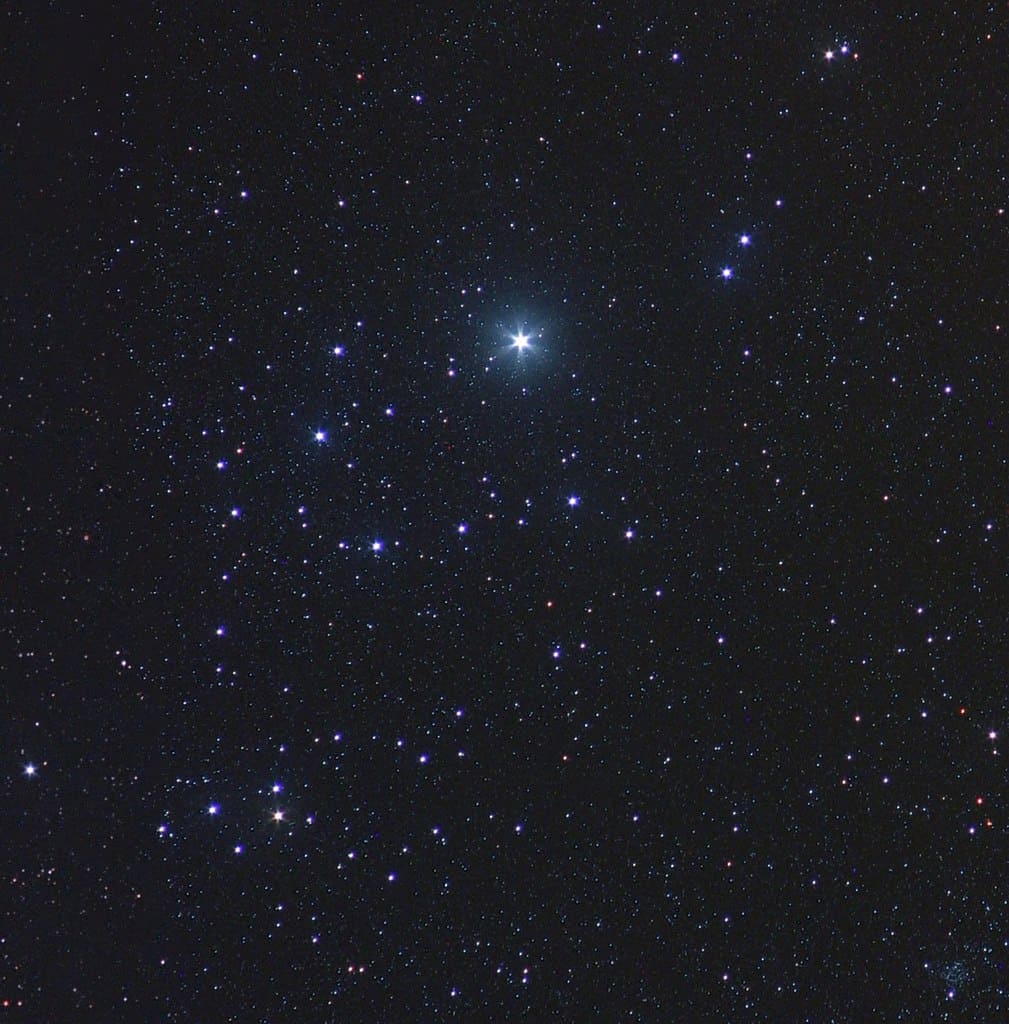
Mirfak has a radial velocity of -2.04 km / -1.26 mi per second, while its rotational velocity is 20 km / 12.4 mi per second. Mirfak lies in a cluster of stars named the Alpha Persei Cluster, being the central star.
Planetary System
Many observations have led some to believe that Mirfak hosts an exoplanet orbiting around it. This planet is yet unconfirmed, yet some data suggests that if it exists, it would have around 6.6 times the mass of Jupiter.
Location
Mirfak / Alpha Persei is located in the constellation of Perseus, being the brightest star there, and it is also the only navigational star of this constellation.
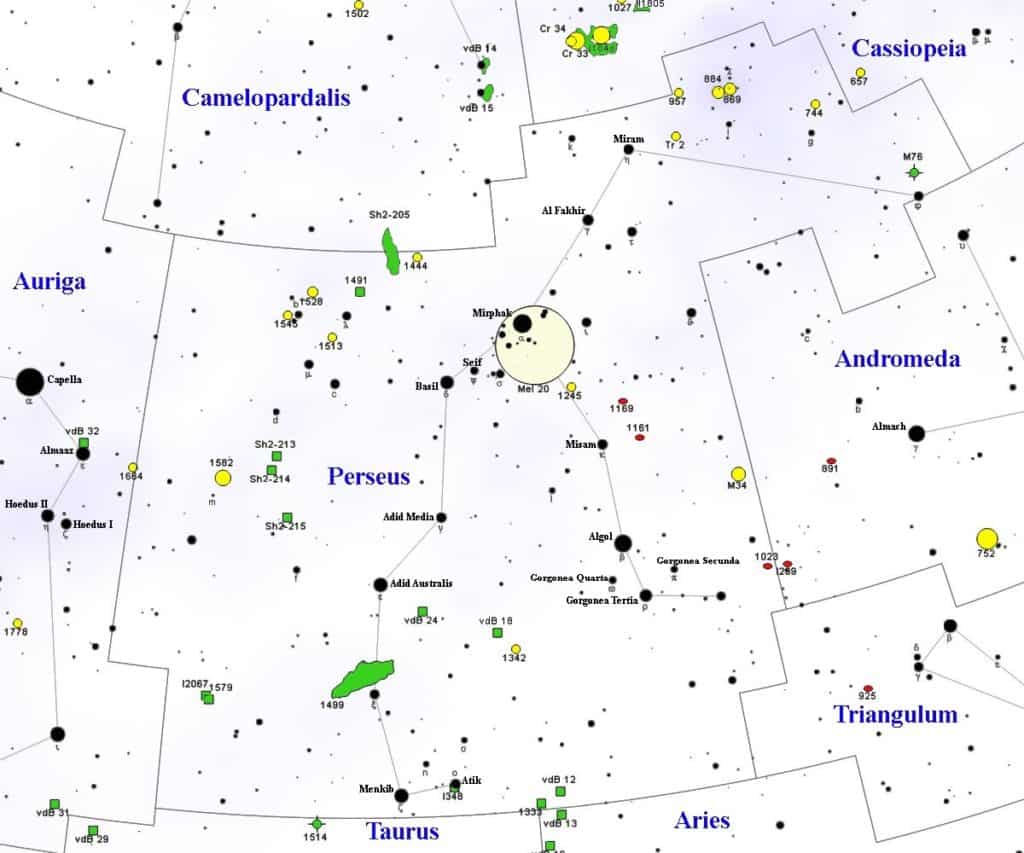
Mirfak is easy to find since it is located near several asterisms. It lies under Cassiopeia’s W-shaped asterism for example. It is also near Capella, one of the vertices of the Winter Hexagon asterism. Mirfak never sets below the horizon for observers in the mid-northern latitudes, thus it is visible throughout the year.
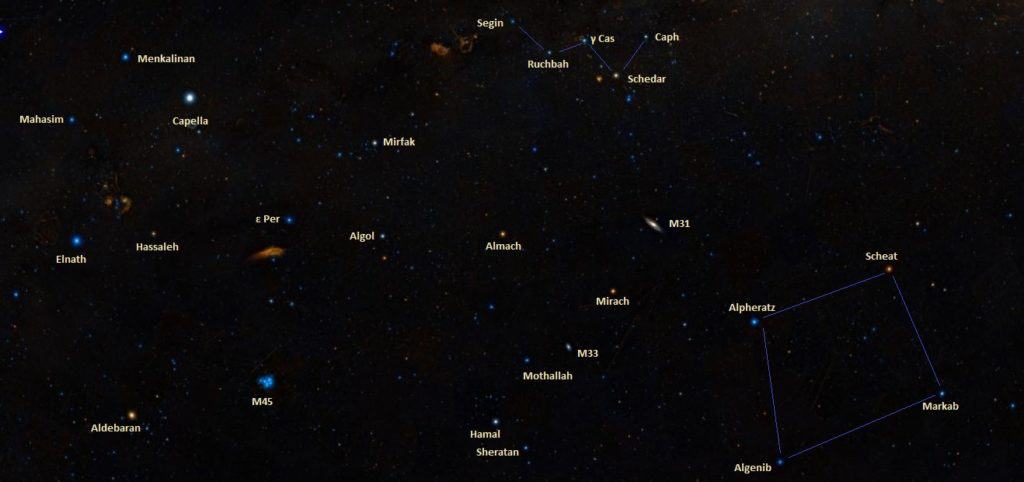
The constellation of Perseus is among the first 48 Greek constellations, listed by the famous astronomer Ptolemy, in his 2nd century Almagest.
Perseus is the 24th largest constellation in the sky, occupying an area of around 615 square degrees. This constellation hosts many interesting stars and deep-sky objects.
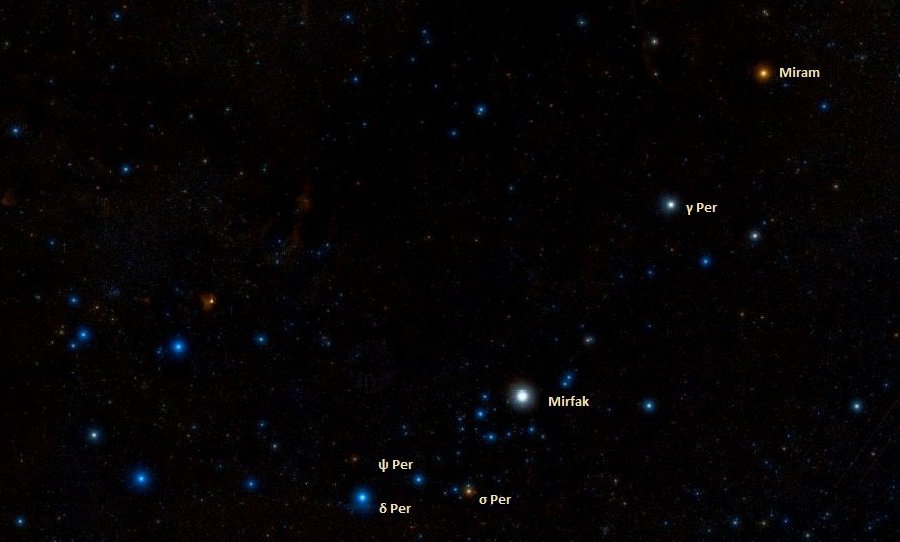
Some of them are, the variable star Algol, the multiple star system Epsilon Persei, the X-ray binary system X Persei, Gorgonea Tertia, GK Persei, the open cluster Messier 34, the NGC 869 and 884 clusters, the planetary nebula Messier 76, the emission nebula NGC 1499, and the lenticular galaxy NGC 1260, among many others.
The best time to observe the stars and deep-sky objects in the constellation of Persei is during the month of December.
Did you know?
- Several deep-sky objects are near Mirfak, some examples are the open clusters NGC 1245 and 1528, or the emission nebula NGC 1491.
- Mirfak was for a time known as Algenib, sharing this name with Gamma Pegasi, one of the stars forming the Great Square of Pegasus.
- In Chinese astronomy, Mirfak is part of an asterism called the Celestial Boat. The star was known to the Chinese as Tian Chuan san – the Third Star of Celestial Boat.
- In Hawaii, Mirfak is known as Hinali’i – it is associated with a tsunami and the start of the migration of Maui. In local lore, the star marks the point where the Earth and the sky were separated when the Milky Way was created.
- Mirfak has been used as a spectral standard for its class since 1943.
- Mirfak is part of the Segment of Perseus, a curved line that dominates the constellation of Perseus, and it is outlined by Miram, Delta Persei, Gamma Persei, Psi Persei, and Sigma Persei.
Sources:
Image Sources:
- https://www.astronomytrek.com/wp-content/uploads/2018/01/Mirfak.jpg
- https://www.star-facts.com/wp-content/uploads/2019/10/Mirfak.jpg?189db0&189db0
- https://www.skyledge.net/Perseus-Mirfak.jpg
- https://www.star-facts.com/wp-content/uploads/2019/10/Mirfak-cluster.jpg
- https://www.star-facts.com/wp-content/uploads/2019/10/Perseus-constellation.jpg
- https://www.star-facts.com/wp-content/uploads/2019/10/Mirfak-location.jpg
- https://www.star-facts.com/wp-content/uploads/2019/10/Segment-of-Perseus.jpg
